AI is rapidly changing the way we work. It’s only been ten months since ChatGPT launched, and since then, we’ve seen a huge increase in AI applications being created and used globally.
OpenAI’s Head of Sales, Aliisa Rosenthal, joined OpenAI a year and a half ago — before ChatGPT launched. She joined a team of two, and there was a lack of product-market fit beyond small groups of researchers.
After the launch of ChatGPT, they went from 30 leads a week to 10,000.
How did they get here?
Aliisa took to the stage at SaaStr Annual to share how far AI has come since the launch of ChatGPT, how it can change the way we work for the better, and what the future holds.
How Did We Get Here — OpenAI
OpenAI started as a research lab in 2015. The goal was to build safe AGI — AGI being autonomous systems that can perform work as well or better than humans.
The goal seemed outlandish and lofty, and the founders were laughed at.
In June 2020, they launched GPT3 — its first state-of-the-art large language model.
GPT3 didn’t cause a tidal wave, but it did spark interest in a small group of researchers.
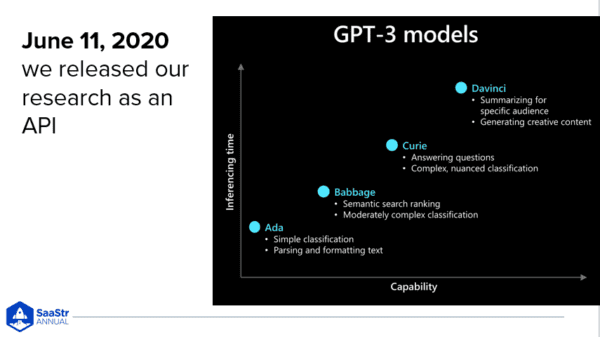
GPT3 had four flavors, ranging from simple classification to the most robust model of Da Vinci. Some companies like Jasper built on top of OpenAI’s models.
From there, the pace picked up rapidly.
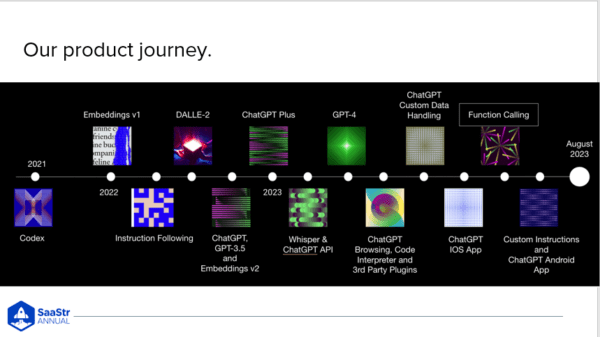
In 2021, they trained GPT3 on Github repositories, produced a model that could code, and released embedding that allowed people to vectorize language and search across it to perform recommendations.
After that, they released instruction following models, which were the first Enterprise-ready models.
Then came the big image model of DALL-E 2, taking the world by storm last summer.
It was exciting then, even though it’s old hat now — an extraordinary leap forward in innovation when released.
From there, the pace picked up even more, releasing ChatGPT, Whisper, and GPT4, the state-of-the-art seminal model.
The training for GPT4 actually finished last August, but they waited to release it because of how powerful it was. The OpenAI team wanted to make sure it was safe.
From there, a lot of new features were released at a blistering pace.
Product Market Fit Wasn’t Quite There
For such an innovative and rapidly growing company, it’s important to remember that every company, no matter how successful, starts at the beginning with trying to find product market fit.
Aliisa joined OpenAI in 2021 after leaving WalkMe after 3.5 years, going public, and even ringing the bell at NASDAQ.
A friend joined Jasper as president and asked her to run the sales team. After digging into the platform and appreciating its capabilities, she found OpenAI.
She met Sam Altman and was blown away by the audacity of his ambition.
Sam said he had no idea what sales would look like at OpenAI or how to go to market with their products, but they went for it.
She went from managing a huge sales organization to being one of two people.
During her first week, she walked in on a meeting and learned they had oversold their license model and needed help undoing it.
This was when she understood they were selling services — buy a license with OpenAI and meet with the team once a week to solve problems and ideate.
It wasn’t a very scalable model, and they ran out of man-hours and services to sell.
The reality was product market fit wasn’t quite there yet. They were stuck in experimental groups and innovation labs and weren’t sure where to go beyond generative copy apps.
They couldn’t figure out chatbots, support, or that next level.
What Are You Selling — A Token Payment Model
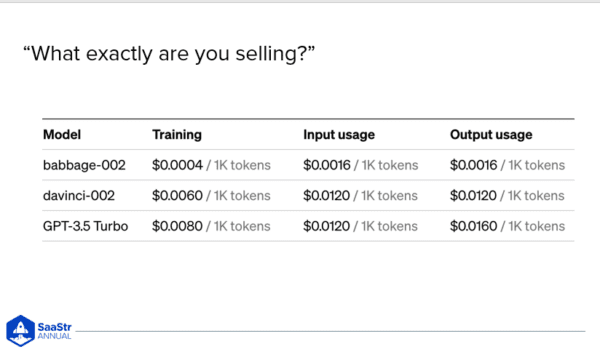
They started playing with a token model — a concept that cost 1.3 tokens per word in the English language.
You consume tokens when you put in a prompt and get an output or completion.
Using this token model, they came up with the Committed Consumption model — all the hyperscalers and API companies use it.
The Committed Consumption model allowed the team to talk to their customers about:
- How they’re implementing OpenAI models
- How many tokens they would consume
- What the forecasted spend was
Then, they could qualify who was a good fit to work with, and they started scaling their customer base.
They had this model in place just in time for ChatGPT. And even though it was a consumer product, it fired off a huge demand among Enterprise and businesses.
At this point, ChatGPT was a consumer app and an API, which is how software companies and Enterprises could build tools on top of the models.
Companies started building real products on OpenAI’s API.
OpenAI got out of beta and innovation labs and into users’ hands. It started with chatbots.
- Discord launched Clyde
- Hubspot launched Chatbot
- Snapchat launched MyAI
Spotify was able to offer better recommendation engines — AI DJ.
Instacart provided conversational grocery shopping — “I have a three and five-year-old, and here’s what is in my fridge. Can you meal plan for a week?”
Notion launched NotionAI.
Eventually, so many companies were launching products, and so many use cases that the OpenAI team had a Slack channel just to track the launches.
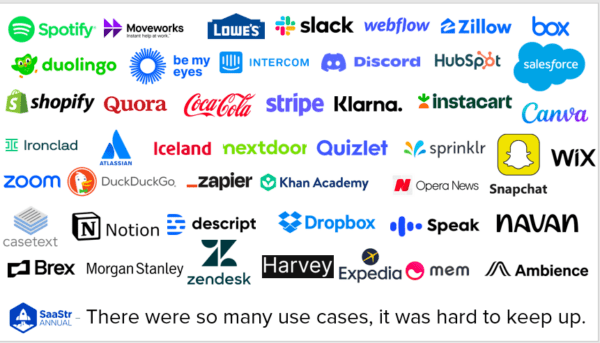
Last week, they launched ChatGPT Enterprise.
A year and a half ago, OpenAI was chill with only two people. Now, there are two different products and sales teams and they’re hiring like crazy.
They’re on a rocket ship. And the main takeaway is to adapt, experiment, and deal with change.
What This Means for Salespeople, Startup Founders, and Anyone Dealing with Customers
OpenAI and AI, in general, have so many uses for salespeople, founders, and anyone dealing with customers.
For example…
OpenAI has a product called Code Interpreter, officially rebranded to Advanced Data Analytics.
This tool allows you to:
- Upload files
- Analyze data
- Produce charts
- Analyze leads
- Cut territories
- Find weak spots in funnels
- Do competitive analysis
Every salesperson in an organization can become a data scientist.
Supercharge Sales Coaching
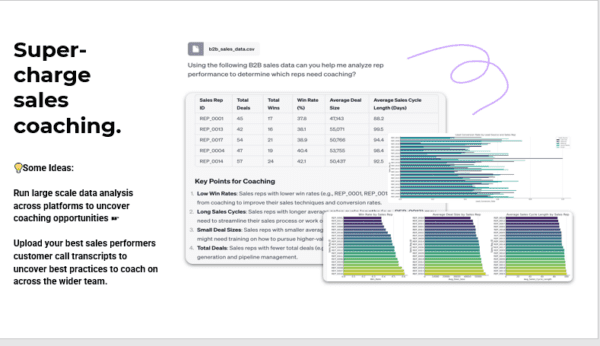
OpenAI can supercharge sales coaching by uploading data sets around win rates and understanding how to coach reps.
You can uplevel one-on-ones, upload transcripts for feedback, and use ChatGPT as a coach or mentor to analyze your performance and offer advice to sales reps.
Share Templates Across Teams
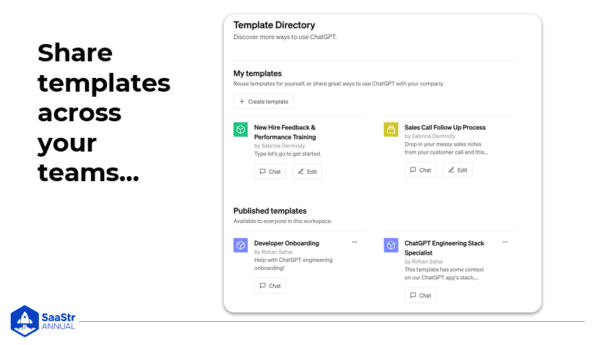
You could create a prompt, throw in your chicken scratch sales notes, and AI puts them into the Salesforce field output for CRM and then generates follow-up emails for you.
You then share that template with the whole company so everyone becomes top-performing reps.
Scale Sales Enablement
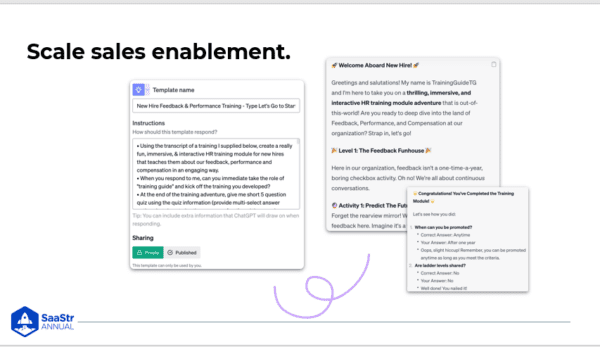
At OpenAI, they’re hiring so rapidly that they need to find a way to get people comfortable with the new products and language of AI.
To scale sales enablement, you can create interactive quizzes on content, and users are prompted to go on an immersive training adventure, which is a lot more fun than an email or Slack message for learning.
You can get everyone the help they need to close deals and succeed.
What Does the Future Hold with AI at the Helm
Imagine a world where you can focus on what you love doing and everything else your assistant can do for you.
You get to interact with customers and explain the value of your products while AGI does everything else.
Imagine you’re getting ready for your day while your assistant preps you on the meetings you’ll have and what happened at the last ones.
During the meeting, your assistant nudges you in a certain direction.
After the meeting, it sends all your follow-up emails, records everything in a CRM, and maybe even goes through legal processes with you.
This is what the future of AI could be in the workplace.

